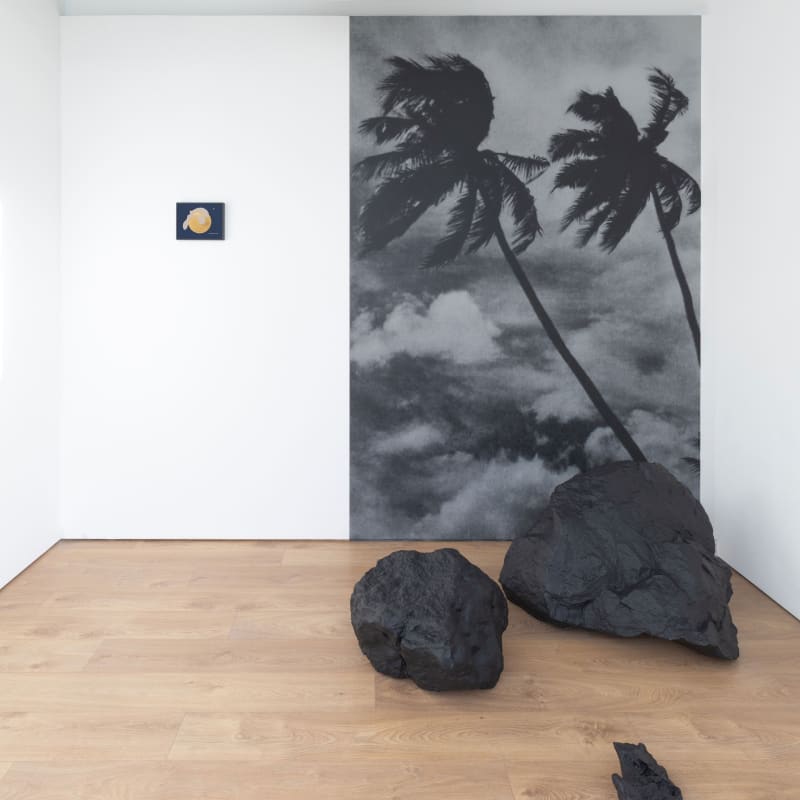Kristin Hjellegjerde Gallery is proud to announce the opening of their new gallery on Tanner Street in London with a solo exhibition titled Shrines of Gaiety by Sinta Tantra. Presenting all new works, the British-Balinese artist invites viewers into a shimmering, golden world filled with abstract floating shapes, the resonant sound of chanting and the heady scent of incense. This devotional space reflects on cultural heritage, consumerism and colonial pasts.
Tantra's works are created in response to time and space, and are designed to subtly transform throughout the day, offering shifting moods and perspectives. This latest exhibition opens with a room of paintings with gold leaf backgrounds that reflect the light, evoking both a sense of warmth and seduction. Precisely applied in square tiles and then burnished, the golden surface appears smooth and flawless from a distance, while closer inspection reveals grid-like joins and the human hand that made them. Organic forms painted in Prussian blue act as an inversion of space, appearing like tunnels through the canvas, contrasting with areas of raw linen.
The compositions are inspired, in part, by Tantra's reading of Paul Scheerbart's short novel, The Light Club of Batavia (1912), which revolves around the construction of a spa that bathes its users not in water but in light. 'I love the magnetic appeal of gold, its energy-given properties throughout the ages,' says Tantra, noting the material's associations with vanity, wealth and power. In the foreground of the paintings, silhouettes and outlines were traced from sketches made over the summer period of the tropical valley overlooking her family's house in Ubud, Bali. This balancing act between light and dark, abundance and minimalism, reflects an internal conflict highlighted in the novel, relating to the human and environmental consequences of colonialism, modernism, and tourism today.
An installation of a blown-up 1930s Balinese postcard of a palm tree, printed onto wallpaper in monochrome, is pasted behind an arrangement of three-dimensional black replica rocks, further exploring this tension. It is a homage to Bali's wild and craggy coastlines, depicting perhaps an idyllic scene. Still, it is also an artificial landscape, a fake like the souvenirs we buy and bring home from our travels. Seen within this context, the landscape becomes non-specific, a stereotype, a kind of no place.
The final room plays scenes from the 1932 film Bird of Paradise on a 10-minute loop. Again, we are transported into a tropical landscape: people are dancing, adorned with floral necklaces and swimming naked in the ocean. It is a stereotypical vision of paradise that evokes sensuality and a carefree attitude. 'I was interested in blurring the boundaries between authenticity and Hollywood', says Tantra. Removing the audio from the film highlights this disconnect. Speakers in the corners of the room play a field recording of chanting from Tantra’s village in Bali, merged with sound clips from the film, further complicating our sense of place. Here, we also find a series of smaller-scale paintings of gold leaf forms on a dark, velvety background of Prussian blue. While the compositions are similarly playful and whimsical, the mood is darker and more meditative, with lines of burning incense sticks creating a temple-like environment. A mural of two overlapping circles, one gold and the other blue, serves as a focal point, playing on the symbolism used in meditation practices and referencing cosmic forms.
In this way, Tantra leads us on a journey through time and place, from light to dark, from the external world into an internal space of contemplation. The works in Shrines of Gaiety are objects of beauty that we may covet and admire simply for their poetic compositions, but like gold itself, there is more to them than meets the eye.
10 November - 20 December 2023
Kristin Hjellegjerde Gallery
36 Tanner Street
London SE1 3LD
